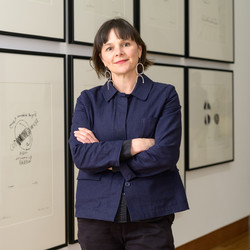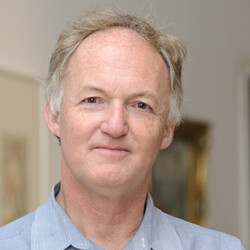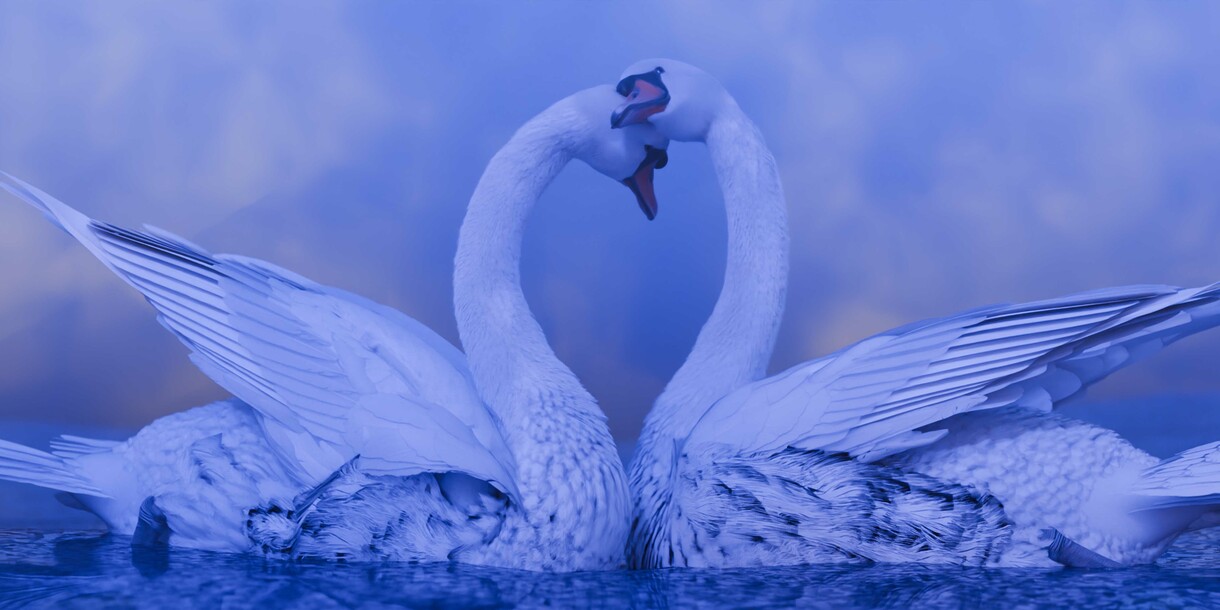Hye Rim Lee
Swan Lake
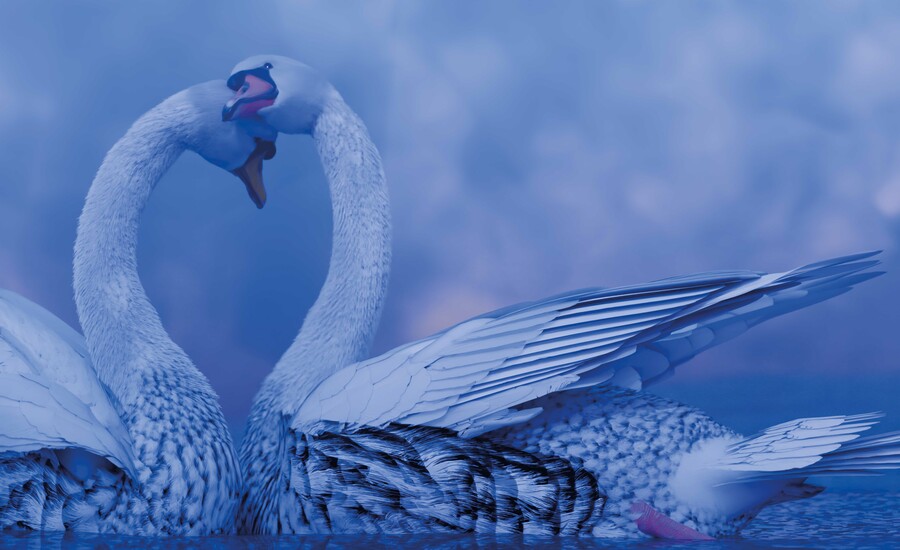
Hye Rim Lee Swan Lake (still) 2025. 3D animation. 3D generalist: Steven Stringer. Courtesy of the artist
The laptop fires up and a dreamlike virtual world materialises. Exquisite peacocks – glassy black, ethereal white – emerge on a moonlit stage, framed by icy blue branching patterns. A cast of swans glide through a luminous, rippling lake in measured arcs, their movements both urgent and graceful. In other scenes, two royal lovers – bound by fate, divided by unseen forces – circle one another, mirroring gestures of longing and hesitation.

Hye Rim Lee Glass Queen 2021. Black Rose image series made from 3D animation Black Rose. 3D generalist: Greg Smith. Courtesy of the artist
We pause over lunch at a bustling Grey Lynn café, reviewing excerpts of the work in progress. Hye Rim Lee notices the esteemed senior painter Jacqueline Fahey at a nearby table – this neighbourhood has long been known as a hub for artists. Our waiter glances at Lee’s screen and pauses. “What’s happening here? That looks interesting.” Stopping to explain isn’t practicable, so we leave it there. Lee’s project takes me to unfamiliar places – one of which we’ve just visited. Te Wai Ōrea is a natural spring-fed lake widely known as Western Springs and is home to many bird species, including kakīānau – black swans. This is where the idea for the new work was sparked, during the first nationwide Level 4 lockdown in 2020 when she began studying, filming and photographing the swans in precious moments of retreat from the walled confines of her Grey Lynn studio. COVID- 19 ushered in a radically unsociable time, but creative endeavour was not completely demolished.
Lee has just received draft material from her new animator and has refinements and interpretations to discuss. I’m lending eyes and ears. At this stage, her avian actors are still in rehearsal – appearing on screen as ‘dolls’ or animatics – testing sequences and movement on rippling, watery stage sets. These choreographed drafts will undergo major further refinement before they are ready for large- screen projection, transforming into something fully realised and immersive.
Lee has exhibited internationally for over two decades and is now experiencing renewed local recognition. She moved from Seoul to Tāmaki Makaurau Auckland in 1993, studying first at Unitec and later at Elam School of Fine Arts. By the early 2000s, she was one of Aotearoa New Zealand’s pioneering digital artists. Five years in New York between 2007 and 2012 solidified her position as a leading intermedia artist, working across digital, sculptural and performance platforms.
From December 2024 until April 2025, Te Papa Tongarewa showcased two major new works, Black Rose (2012–21) and White Rose (2022), newly acquired and immaculately presented on vast, opposite-facing screens. Paired together as Āke Tonu Atu | Eternity, these works featured Lee’s signature mass-media/cyber/anime- inspired character, TOKI. While her actions were mirrored, the narratives shifted, reflecting the passage of time and transformation in TOKI’s identity. In Black Rose, TOKI embodies the struggle to overpower grief, darkness and death; in White Rose, she crosses a threshold into hope, light and eternity. Both works are boldly provocative, set in emotional and fantastical landscapes where TOKI’s form embodies both self-avowal and self-protection, with thorns emerging from exposed, sinuous limbs and torso. Further surrealistic elements – dancing mushrooms, swirling gold or pink ice creams, inflated beach balls, flying duck swim rings and rabbits pooping diamonds – populate the screens, set to a coolly detached soundtrack by Ladyfish, commissioned by Lee.
In Swan Lake, Lee constructs a similarly immersive and dramatic spectacle, again following a trajectory of transformation from darkness to light. While likewise embedded with emotional and symbolic layers, the performing cast is now changed. TOKI is no longer onstage, and the swans are simply swans – no avatars, self- projections or humans enacting swans, as in the original ballet. At the same time, the work continues to enlarge Lee’s foundational themes and imaginative worlds.
Much of her earlier work, as she explains, explored “Asian women living as immigrants in western society as well as sexuality and female identity.” She describes this as being shaped in part by her experience as a Korean woman in the 1970s and 1990s – “a very dark and grey period” marked by political upheaval. “We had protests, dictators, coups, and always army tanks outside the university, gas guns.” Alongside this overt repression, there was something more persistent and subtle in societal attitudes and expectations around women’s appearance and roles. She describes her early work, leading into the creation of TOKI, as “more like the woman’s twisted and idealized image – sexualized – made by [a] male dominant area of plastic surgery, computer games, and cyber culture. Hence, TOKI was born and evolved with those issues as a distorted body, highlighting this problematic area of contemporary culture.”
From these many layers of the TOKI period, we now see a shift. Swan Lake takes creative risks in its apparent sweetness and sincerity. It owns its own space without any evident anxiety for how a more impassive audience might respond. In this, it feels like defiance – a renunciation of artistic constraint and a different kind of external control. Lee’s interpretation draws inspiration from Tchaikovsky’s ballet and references a recorded Nureyev choreography, but it reshapes the narrative, expanding the story with her own imaginative elements. “It’s a complete twist,” she explains. “Not the same as the ballet at all. A lot of components will be added and deleted from the original acts.” New elements so far include peacocks, glass insects, and a colossal, mirrored heavenly rose. As the project grows in scope and complexity, the story carries and conceals its own meanings.
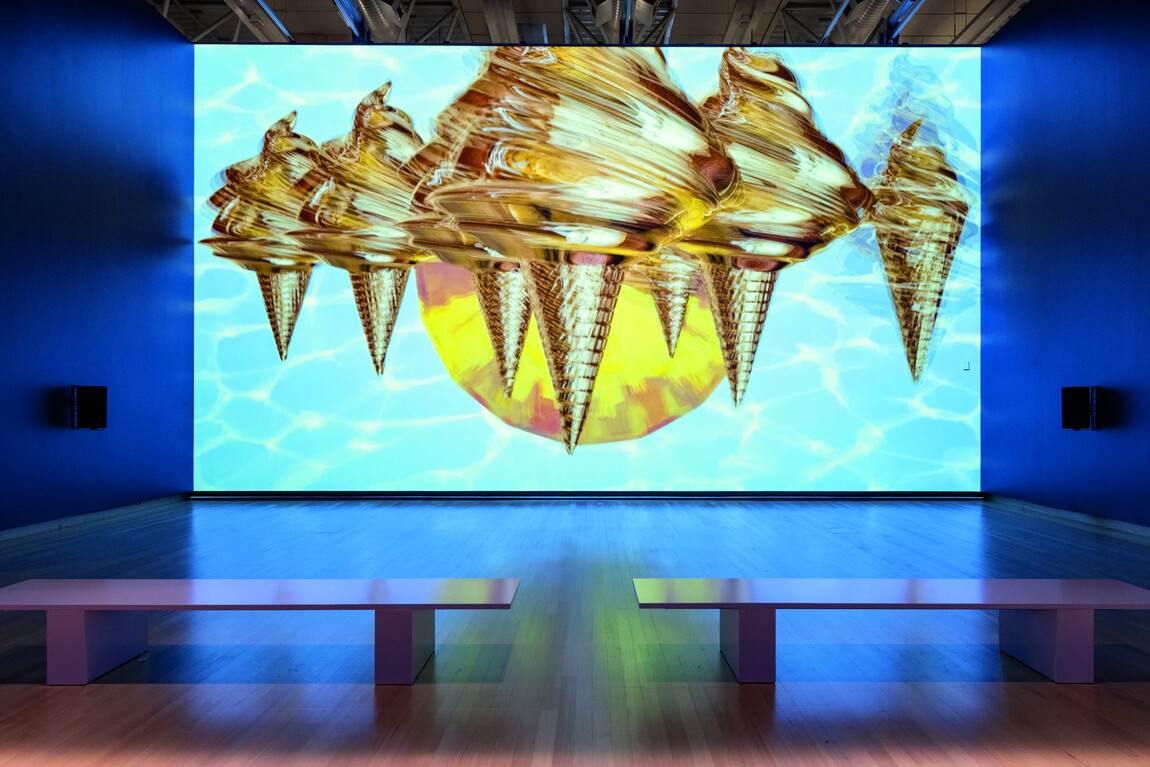
Hye Rim Lee White Rose (2022) in Āke Tonu Atu | Eternity, Te Papa Tongarewa, 2024–5. 3D generalist: Greg Smith. Sound: Ladyfish. Courtesy of Te Papa Tongarewa
Here, we also see the influence of Lee’s upbringing, which she describes as deeply performative, and immersed in music, theatre and dance.
“I started singing at the age of three; I was a child prodigy and had an amazing voice and musicality. I could read complicated opera scores. At eight or nine, I regularly appeared on a TV programme called Come and Sing and once sang in front of 3,000 people. By fifteen, I was singing opera. I was a church soloist until I lost my voice at nineteen. I was a Mozart singer, especially coloratura – I could sing The Queen of The Night from The Magic Flute.”
Her elder sister Hye Ju was similarly gifted, but as a pianist. Their parents had fled North Korea near the outbreak of the Korean War and became prominent figures in South Korean theatre and opera. Their father, Jin Soon Lee, was a key figure in the development of Korean theatre, founding his own company and coining the term Changeuk (Korean opera). Elevating this to a grand scale, he also regularly directed for other companies and performed European opera, ballet and theatre, including experimental work and introducing Shakespeare and Chekov to Korean audiences. Their mother, Moon Sook Jeong, had escaped North Korea on foot and eventually became a leading soprano. Their deaths – his in 1981 while Lee was still at university, hers four years later – left a profound void, compounded greatly by the loss of her sister who was by then a concert pianist living with her family in Boston, in 2008, the year after Hye Rim Lee moved to New York.

Hye Rim Lee Black Rose (2012–21) in Āke Tonu Atu | Eternity, Te Papa Tongarewa, 2024–5. 3D generalist: Greg Smith. Sound: Ladyfish. Courtesy of Te Papa Tongarewa
Black Rose remains a powerful expression of and response to a period marked by loss and despairing escapism, as TOKI faces her own mortality. Yet, as seen in Āke Tonu Atu| Eternity at Te Papa and the semi-mirrored White Rose, this gives way to a sense of regeneration – birthed and sustained by Lee’s redeveloping faith, and continued in her exploration around the construction of identity. Rather than imposing certainty, belief has evidently shaped Lee’s vision, resilience and capacity for reinvention, fuelling her engagement with complexity and transformation.
The creation of Swan Lake might then be seen as part of a broader process of healing and reclamation – not only a pull towards rediscovery of childhood innocence, hope and imagination, but also Lee’s reconnection with her rich cultural and personal heritage. This process of artistic and spiritual renewal reveals the artist’s deepening engagement with both past and present, shaping a path forward that is as reflective and inventive as it is boldly liberating.


